February 2025
The global public transportation market size was USD 223.91 billion in 2023, calculated at USD 240.97 billion in 2024 and is expected to be worth around USD 502.22 billion by 2034. The market is slated to expand at 7.62% CAGR from 2024 to 2034.
The global public transportation market size is projected to be worth around USD 28.89 billion by 2034 from USD 6.11 billion in 2024, at a CAGR of 16.81% from 2024 to 2034.
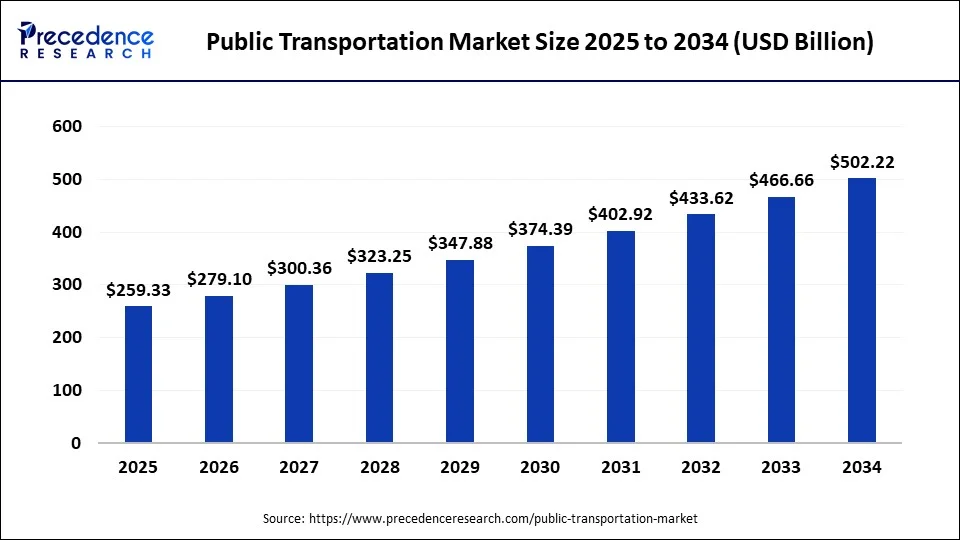
The Asia Pacific public transportation market size was exhibited at USD 105.24 billion in 2023 and is projected to be worth around USD 236.04 billion by 2034, poised to grow at a CAGR of 7.66% from 2024 to 2034.
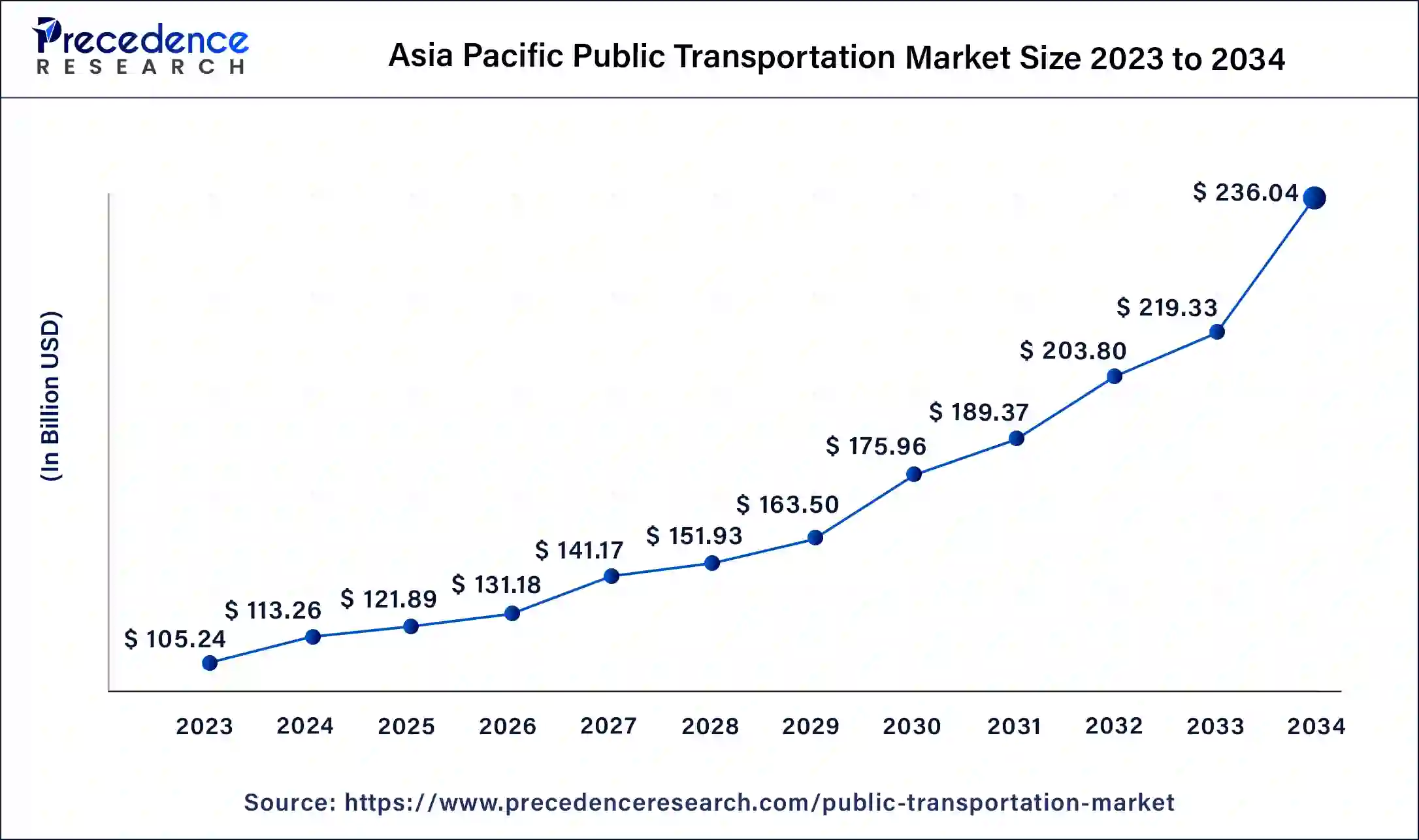
Asia Pacific held the dominant share of the public transportation market in 2023 and is expected to witness prolific growth during the forecast period. Developing countries such as China, Japan, and India are the leading contributors to the market owing to rapid urbanization, the presence of stringent emission norms and regulations, increasing development of charging infrastructure, a significant rise in population, and rising traffic congestion, which facilitates the sophisticated development of public transportation systems to reduce traffic congestion and pollution as well as providing accessible mobility options.
The rising adoption of emerging technology is anticipated to enhance the safety, efficiency, and convenience of public transportation. Moreover, the government is actively engaged in investments and supportive initiatives for infrastructure development, including rail networks, metro systems, and bus rapid transit systems to improve public transportation networks and promote sustainable transportation options among lower and middle-class people.
Furthermore, reasonably priced public transportation is accelerating the expansion of the market as the region has a large population of lower and middle-income individuals who cannot afford private vehicles; instead, they rely on public transit for their daily commute. Therefore, such factors are responsible for making the region a key catalyst for the robust growth of the public transportation market.
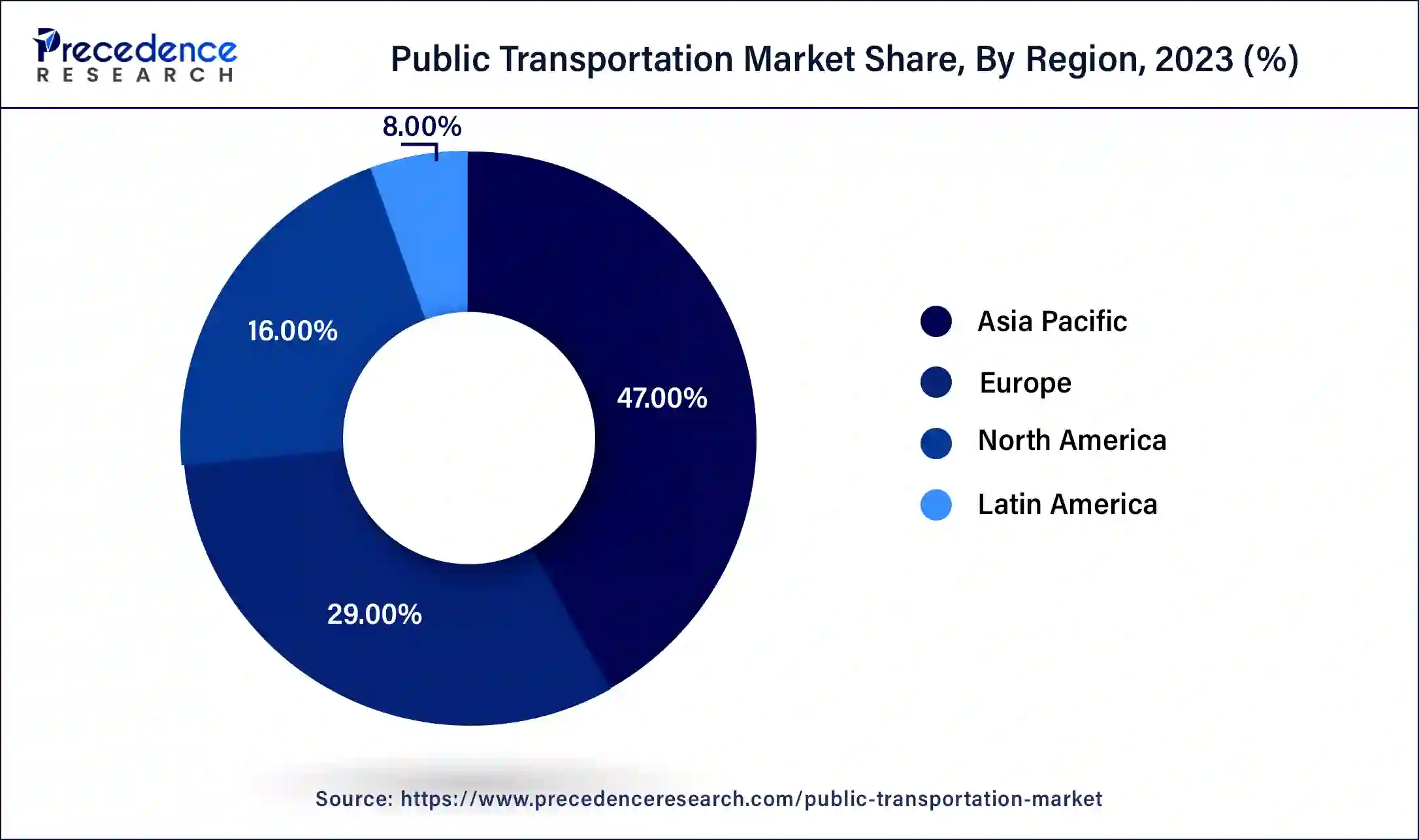
North America is observed to expand at a rapid pace in the public transportation market during the forecast period. The market has witnessed a rising demand for affordable public transportation owing to the high cost of private transportation in the region. Additionally, the government's rising investment is expected to facilitate access to affordable public transportation facilities, which further reduce congestion, lower carbon emissions, and combat climate change. The presence of sophisticated charging infrastructure for electric buses, coupled with rapid technological advancements, including mobile ticketing and real-time transport information systems (RTIS), improves the commuters' experience. Thereby fostering the growth of the North American market.
The public transportation market provides transportation services to the public using several modes of shared mobility. It comprises numerous modes, including buses, subways, trains, and others. Public transportation services play an integral role in facilitating the movement of people within cities and metropolitan areas, which aids in reducing traffic congestion, lowering the environmental impact, and fostering sustainable urban development. Public transportation services are generally operated and managed by government bodies, municipal authorities, or public agencies.
Integration of Artificial Intelligence in Public Transport Industry
Artificial Intelligence is now a staple in modern public transport vehicles with features such as automated parking assistance, 360-degree cameras, and in-cabin monitoring for the safety of passengers and drivers. Predictive analytics and AI algorithms are used for object detection for driving engineers that minimizes the risks of possible threats or accidents. The software-integrated cameras help with visualization and computational photography with the help of sensors. Customer-service chatbots assist the public in real-time vehicle tracking and automated vehicles analyze driver behavior patterns for overall security. Natural language processing ensures the correct communication and customer query-solving approach.
| Report Coverage | Details |
| Market Size by 2034 | USD 502.22 Billion |
| Market Size in 2023 | USD 223.91 Billion |
| Market Size in 2024 | USD 240.97 Billion |
| Market Growth Rate from 2024 to 2034 | CAGR of 7.62% |
| Largest Market | Asia Pacific |
| Base Year | 2023 |
| Forecast Period | 2024 to 2034 |
| Segments Covered | Mode Type, Distribution Channel, and Regions |
| Regions Covered | North America, Europe, Asia-Pacific, Latin America and Middle East & Africa |
Increasing adoption of electric bus
The significant rise in electric bus adoption due to the rise in environmental concerns globally is expected to accelerate the growth of the public transportation market. Electric bus adoption in public transportation is growing all over the world. The surge in pollution levels and the adverse effects of greenhouse gas emissions on the environment have boosted the demand for eco-friendly vehicles. The usage of electric or hybrid buses and trains reduces the dependency on fossil fuels and promotes greener transportation. Therefore, the increasing manufacturing of electric buses for public transportation will largely contribute to the market's growth during the forecast period.
The European e-bus market saw a 53% growth in registrations last year: in 2023, as many as 6,354 were registered in EU27 + Norway, Iceland, and Switzerland. Over 42% of city buses were zero-emission (BEV and Hydrogen), quickly growing from 15% in 2020. According to figures by Chatrou CME Solutions, Overall, 13,466 buses with alternative drivelines were registered, reflecting a 41% increase from the previous year.
Increasing preference for passenger vehicles and two-wheelers
The growing sales of passenger vehicles and two-wheelers are anticipated to hamper the market's growth. In recent years, the market has witnessed an increase in the purchase of passenger vehicles and two-wheelers, which has reduced the usage of public transportation among the general public. Thus, increasing the number of private and personal modes of transportation has resulted in the rising utilization of public transportation and may restrict the expansion of the global public transportation market.
According to the Society of Indian Automobile Manufacturers (SIAM):
Opportunity
Supportive government framework
The supportive role of the government is projected to create significant growth opportunities for the growth of the global public transportation market during the forecast period. Governments around the world are promoting travel through public transportation by offering low-cost fares and providing free services to some age and female categories. The surge in the number of private vehicles on roads causes traffic congestion and environmental issues, which compels government bodies and travel agencies to work in collaboration to resolve this issue by promoting public transportation modes among commuters.
Reducing traffic congestion requires sustainable public transportation and further increases the usage of rail, metro, and bus rapid transit. The government is highly investing in developing smart cities with advanced public transportation infrastructure. Cities are facilitated with efficient public transportation and urban mobility. Several governments have announced tax exemptions and subsidies for the purchase of electric buses to promote green transportation. Thus, Governments play an integral part in promoting public transportation through the execution of policies, regulations, and investments and are expected to drive the public transportation market during the forecast period.
The road segment held the largest share of the public transportation market in 2023 and is expected to sustain its position throughout the forecast period. The road segment held the largest segment of the public transportation market in 2023, and the segment is expected to sustain its position throughout the forecast period owing to the increasing demand for affordable and accessible transportation facilities. In public transportation, roads play an essential role by offering feasible solutions and necessary infrastructure for efficient transportation networks, as well as reducing the impact of traffic congestion on modern roads.
The establishment of well-developed road networks enables the seamless flow of public transit vehicles and allows travelers to reach their destinations safely and quickly. High-quality roads for buses and rapid transit systems improve efficiency and enhance the speed of public transportation, making it a cost-effective option for commuters. The widespread adoption of EV buses, coupled with increasing usage of a bus rapid transit system in various megacities globally, is expected to accelerate the growth of the public transportation market.
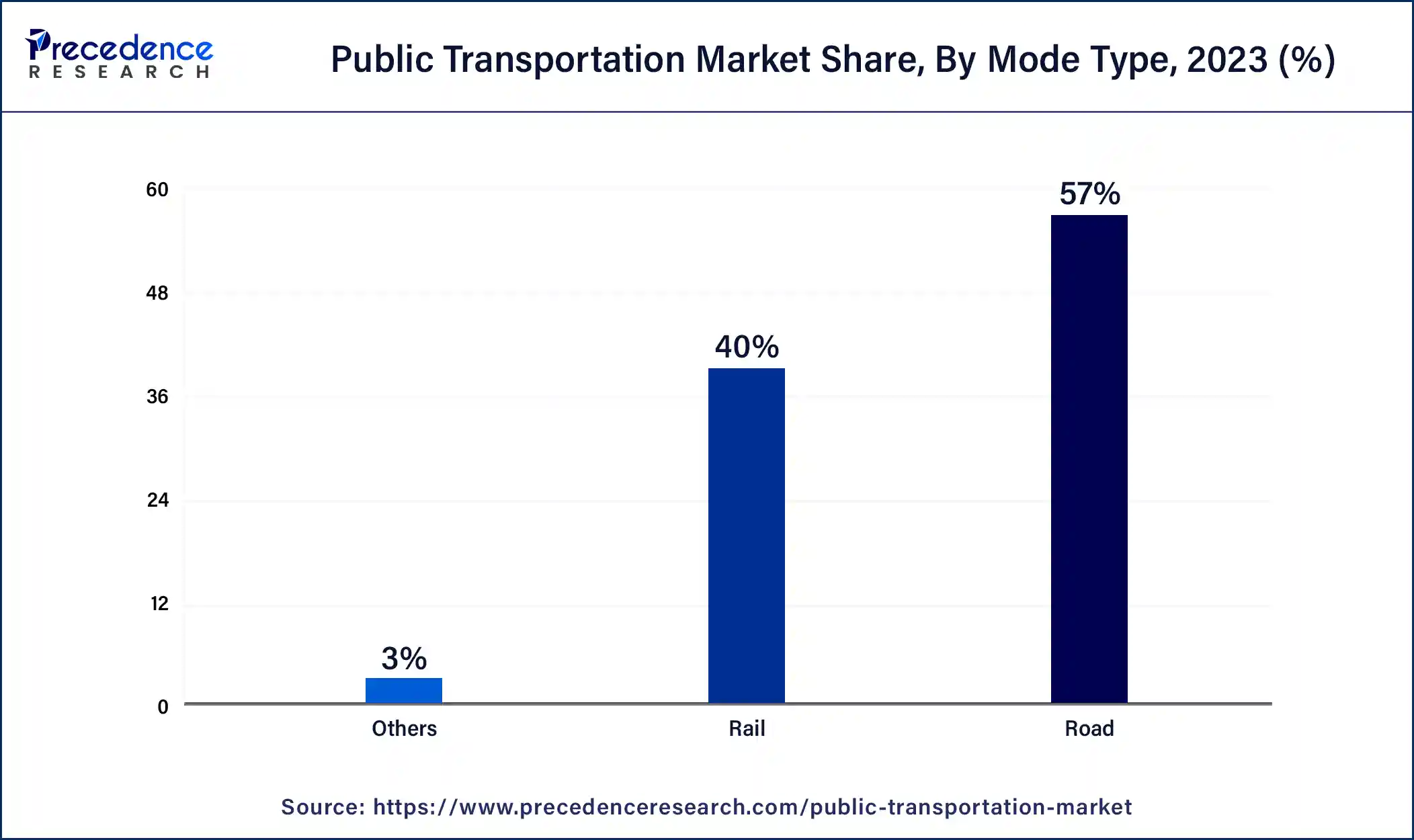
The rail segment is expected to grow significantly in the public transportation market during the forecast period. Rail transportation plays a crucial role in offering reliable, congestion-reducing transportation solutions, reducing travel times, and providing quick modes of transportation. Rail systems include subways, metros, and light rail. Rail transport is highly preferable for long distances at low prices and also increases the travel of people across cities and rural areas.
The growth of the rail segment is majorly driven by the increasing traffic congestion on the roads owing to the rise in the number of private and public vehicles, which increases the travel time. Rail transport uses advanced driver assistance systems (ADAS) to improve safety, enhance operational management, reduce costs, and optimize energy consumption. Additionally, governments around the world are increasingly investing in expanding and improving rail infrastructure to address traffic congestion and promote sustainable transportation options. Such factors are propelling the growth of the segment during the forecast period.
The offline segment led the public transportation market in 2023. This segment is an established and oldest form of distribution channel in the public transport industry. Offline distribution channels include buses, trains, metro, and ferries that operate on fixed routes and schedules. It is a widely used distribution channel for public transit ticketing. Offline distribution channels include agents, ticket counters, kiosks, and others located at transportation stations and terminals. Offline mode distribution channels offer face-to-face interactions and provide convenience in purchasing tickets and other related information services, such as inquiring about routes and schedules and receiving personalized assistance.
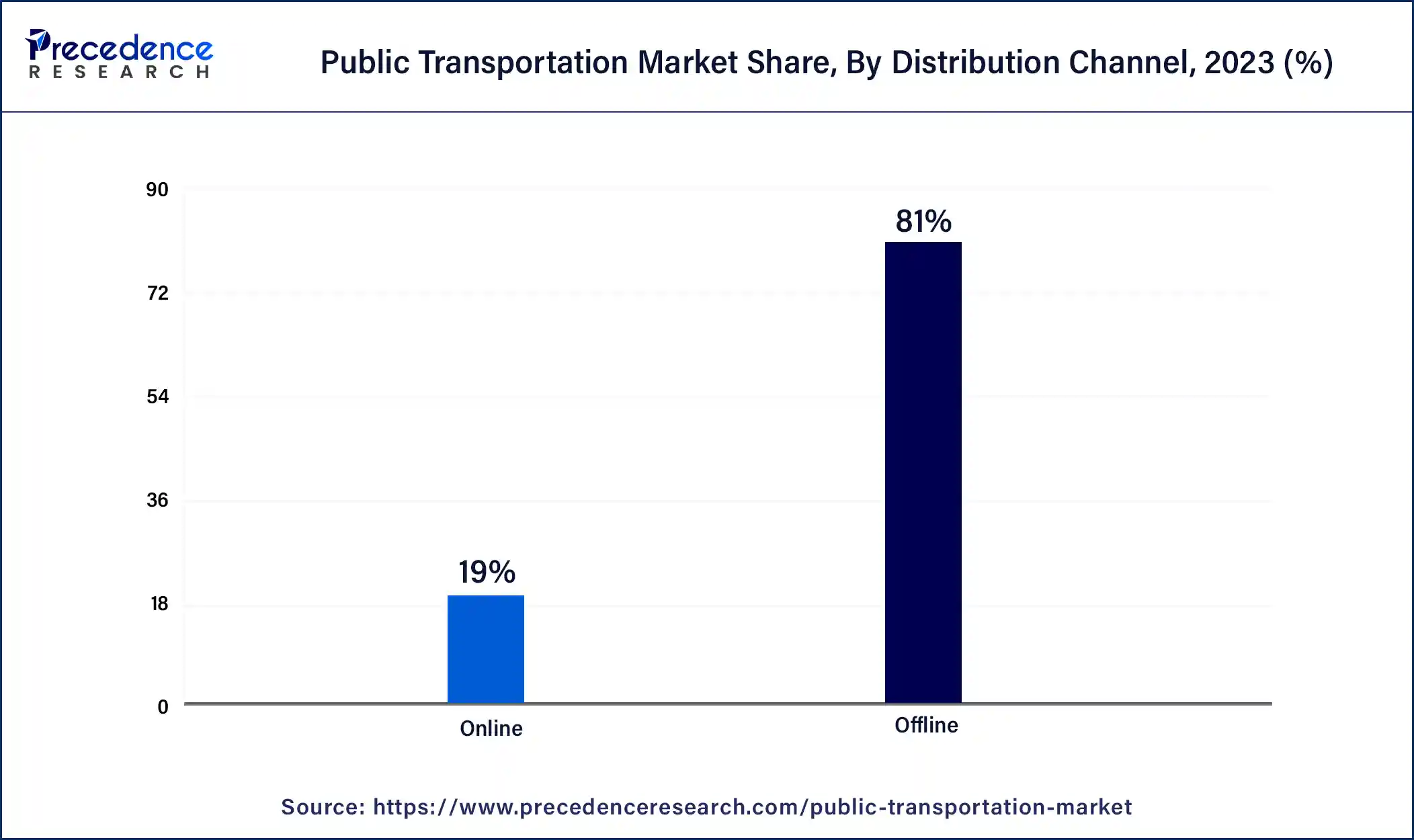
The online segment is observed to grow at a notable rate in the public transportation market during the forecast period. The rapid pace of digitization globally is reshaping public transportation and offering travelers comfort and convenience through real-time information. The online platform allows users to access real-time information, purchase tickets, plan routes, make contactless payments, reduce waiting times, and improve overall travel experiences. The increasing penetration of internet connectivity, rising usage of smartphones, and surge in the number of tourists are fueling the growth of the segment during the forecast period.
Segments Covered in the Report
By Mode Type
By Distribution Channel
By Geography
For inquiries regarding discounts, bulk purchases, or customization requests, please contact us at sales@precedenceresearch.com
No cookie-cutter, only authentic analysis – take the 1st step to become a Precedence Research client
February 2025
February 2025
April 2025
May 2024